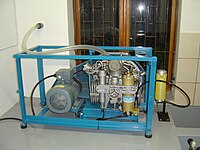
Photo from wikipedia
This paper aims to establish a numerical model to calculate contact pressure for rectangular vane sealing surface of hydraulic rotary actuator. Numerical model can be applied to solve the steady-state… Click to show full abstract
This paper aims to establish a numerical model to calculate contact pressure for rectangular vane sealing surface of hydraulic rotary actuator. Numerical model can be applied to solve the steady-state Reynolds equation after the oil film thickness and the contact pressure distribution curve of the vane sealing surface are obtained.,The authors established the numerical model of contact pressure base on the theory of elastic after, the Reynolds equation is solved by the inverse solution.,The relationship between the oil film thickness of vane sealing surface and the contact pressure on different sealing location for hydraulic rotary actuator is obtained. At the same time, the lubrication state on the surface of seal is also found when the hydraulic rotary actuator runs stably.,The study shows that the lubricating state of the vane sealing surface is mixed lubrication, when the rotor of the hydraulic rotary actuator is running stably at a certain speed. Meanwhile, this research will provide a theory basis for later experiment for the hydraulic rotary vane actuator.
Journal Title: Industrial Lubrication and Tribology
Year Published: 2018
Link to full text (if available)
Share on Social Media: Sign Up to like & get
recommendations!